17供应链管理试题及答案
- 格式:doc
- 大小:37.00 KB
- 文档页数:4
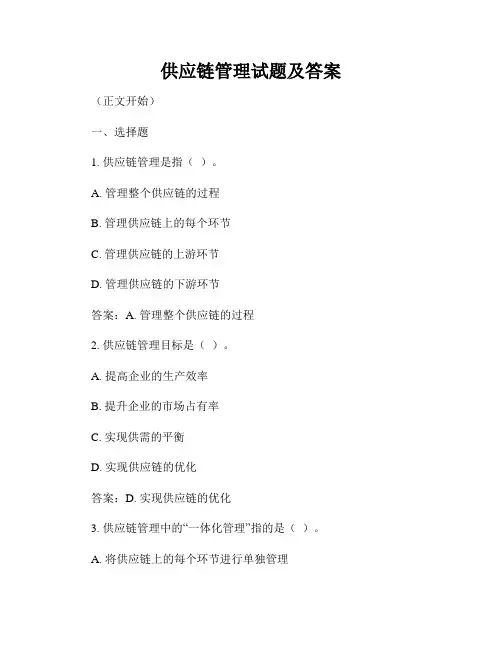
供应链管理试题及答案(正文开始)一、选择题1. 供应链管理是指()。
A. 管理整个供应链的过程B. 管理供应链上的每个环节C. 管理供应链的上游环节D. 管理供应链的下游环节答案:A. 管理整个供应链的过程2. 供应链管理目标是()。
A. 提高企业的生产效率B. 提升企业的市场占有率C. 实现供需的平衡D. 实现供应链的优化答案:D. 实现供应链的优化3. 供应链管理中的“一体化管理”指的是()。
A. 将供应链上的每个环节进行单独管理B. 将供应链上的所有环节整合为一个整体进行管理C. 将供应链上的关键环节进行重点管理D. 将供应链的上游环节与下游环节进行分开管理答案:B. 将供应链上的所有环节整合为一个整体进行管理4. 供应链管理中的“信息共享”是指()。
A. 各环节之间分享实时的供应链信息B. 供应链的信息只在同一环节内进行共享C. 供应链的信息只在上游环节进行共享D. 供应链的信息只在下游环节进行共享答案:A. 各环节之间分享实时的供应链信息二、填空题1. 供应链管理的核心是()。
答案:协调2. 供应链管理的关键是()和()。
答案:信息共享,合作3. 供应链的成本由()、()和()组成。
答案:物流成本,库存成本,信息成本三、简答题1. 请简述供应链管理的重要性及其优势。
答案:供应链管理在现代企业运营中具有重要性。
它可以帮助企业实现供应链上的协调和优化,通过整合各个环节的资源和信息,提升供应链的效率和灵活性。
供应链管理的优势包括降低成本、提高服务质量、缩短交货时间、减少库存压力等。
通过有效的供应链管理,企业可以更好地满足市场需求,提升竞争力。
2. 请阐述供应链管理中的关键环节及其作用。
答案:供应链管理中的关键环节包括供应商选择、采购管理、生产计划、物流管理和售后服务。
供应商选择是建立稳定供应链的基础,通过选择合适的供应商,确保供应链上原材料和零部件的稳定供应;采购管理是对采购过程进行有效控制和管理,确保原材料的质量和价格;生产计划是根据市场需求和资源情况进行合理安排,保证生产的顺畅进行;物流管理是对物流过程进行管控,确保产品及时送达客户手中;售后服务是提供及时的售后支持和服务,增强客户满意度。
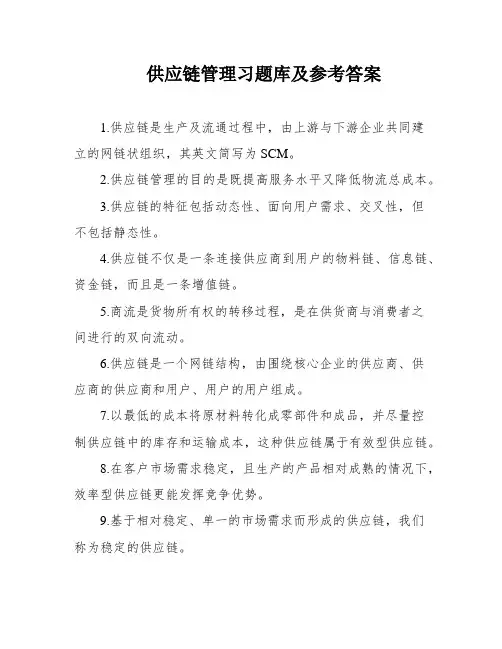
供应链管理习题库及参考答案1.供应链是生产及流通过程中,由上游与下游企业共同建立的网链状组织,其英文简写为SCM。
2.供应链管理的目的是既提高服务水平又降低物流总成本。
3.供应链的特征包括动态性、面向用户需求、交叉性,但不包括静态性。
4.供应链不仅是一条连接供应商到用户的物料链、信息链、资金链,而且是一条增值链。
5.商流是货物所有权的转移过程,是在供货商与消费者之间进行的双向流动。
6.供应链是一个网链结构,由围绕核心企业的供应商、供应商的供应商和用户、用户的用户组成。
7.以最低的成本将原材料转化成零部件和成品,并尽量控制供应链中的库存和运输成本,这种供应链属于有效型供应链。
8.在客户市场需求稳定,且生产的产品相对成熟的情况下,效率型供应链更能发挥竞争优势。
9.基于相对稳定、单一的市场需求而形成的供应链,我们称为稳定的供应链。
10.在市场变化加剧情况下,若供应链成本增加,库存增加、浪费增加时,企业不能在最优状态下运作,此时的供应链是倾斜供应链。
11.当企业订购的产品数量大、竞争激烈时,合作伙伴选择最适宜的方法是招标法。
12.对于长期合作需求而言,合作伙伴应选择战略性合作伙伴。
13.供应链合作关系特征不包括供应链的动态性。
1.供应链的有效运营需要考虑灵敏度、应变能力、精简、柔性和协调等方面。
2.简洁性原则是供应链设计的重要原则之一,每个节点都应该精简、具有活力,并能够快速组合业务流程以快速响应市场。
3.功能性产品和创新性产品是按市场需求模式分类的两种产品类型,钢铁属于功能性产品。
4.平均缺货率高不属于功能性产品的特征。
5.边际贡献率5%-20%、产品生命周期为3个月-1年、平均缺货率10%-40%属于功能型产品的特征。
6.季末降价率高属于创新型产品的特征。
7.在为企业寻找有效的供应链前,需要确定市场需求、企业供应链类型和业务战略,并使它们相匹配和相适应,以实现产品和供应链的有效组合。
8.产品生命周期引入期的供应链策略之一是高频率、小批量的发货。
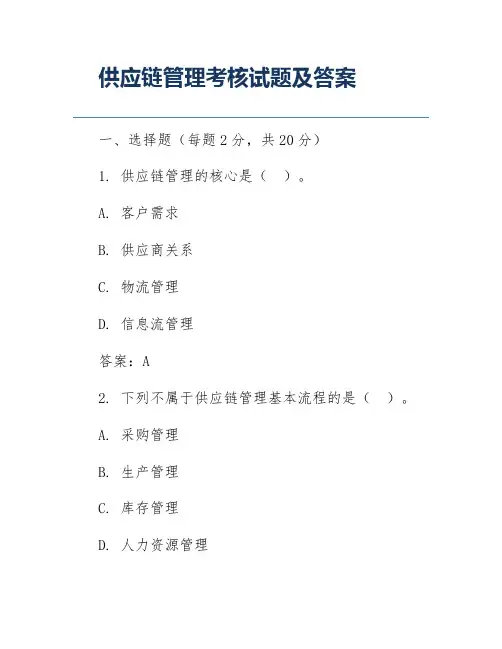
供应链管理考核试题及答案一、选择题(每题2分,共20分)1. 供应链管理的核心是()。
A. 客户需求B. 供应商关系C. 物流管理D. 信息流管理答案:A2. 下列不属于供应链管理基本流程的是()。
A. 采购管理B. 生产管理C. 库存管理D. 人力资源管理答案:D3. 下列哪种组织结构不利于供应链管理的协同效应()。
A. 矩阵式组织结构B. 事业部制组织结构C. 直线式组织结构D. 网络型组织结构答案:C4. 在供应链中,第三方物流供应商的主要职责是()。
A. 负责供应链中的全部物流活动B. 负责供应链中的部分物流活动C. 负责供应链中的信息流和物流活动D. 负责供应链中的资金流和物流活动答案:B5. 供应链风险管理主要包括()。
A. 供应风险B. 生产风险C. 市场风险D. 所有以上风险答案:D6. 下列哪项不是供应链管理的绩效指标()。
A. 订单履行率B. 库存周转率C. 供应商满意度D. 员工满意度答案:D7. 实施供应链管理的企业需要具备的条件有()。
A. 良好的信息技术支持B. 强大的市场竞争力C. 完善的供应链管理体系D. 所有以上条件答案:D8. 供应链协同效应的核心是()。
A. 资源共享B. 流程整合C. 信息共享D. 组织整合答案:C9. 下列哪种方式不属于供应链金融服务的范畴()。
A. 融资服务B. 贷款服务C. 信用保险服务D. 库存管理服务答案:D10. 供应链管理中的可持续发展主要包括()。
A. 环境友好型供应链B. 社会责任型供应链C. 经济效益型供应链D. 所有以上类型答案:D二、简答题(每题10分,共40分)1. 请简述供应链管理的概念及其目标。
答案:供应链管理是指在满足客户需求的前提下,对供应链中的物流、信息流和资金流进行有效整合和优化,以降低供应链总成本,提高供应链的运作效率和响应速度,实现供应链的可持续发展。
供应链管理的目标主要包括降低成本、提高客户满意度、提高供应链的灵活性和稳定性、提高供应链的竞争优势等。
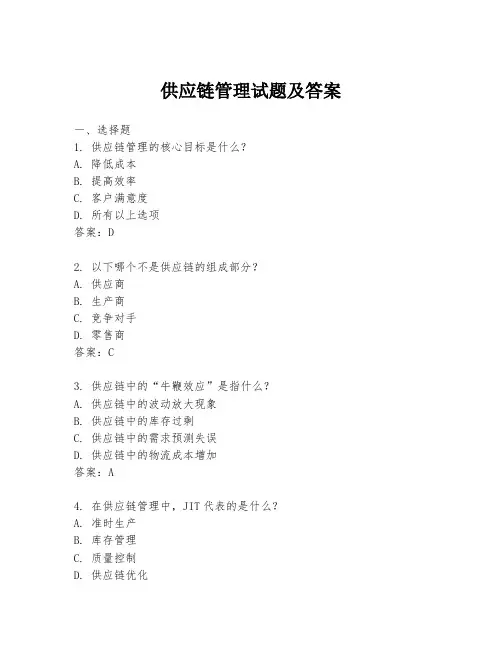
供应链管理试题及答案一、选择题1. 供应链管理的核心目标是什么?A. 降低成本B. 提高效率C. 客户满意度D. 所有以上选项答案:D2. 以下哪个不是供应链的组成部分?A. 供应商B. 生产商C. 竞争对手D. 零售商答案:C3. 供应链中的“牛鞭效应”是指什么?A. 供应链中的波动放大现象B. 供应链中的库存过剩C. 供应链中的需求预测失误D. 供应链中的物流成本增加答案:A4. 在供应链管理中,JIT代表的是什么?A. 准时生产B. 库存管理C. 质量控制D. 供应链优化答案:A5. 供应链风险管理的主要目的是什么?A. 减少供应链成本B. 增加供应链效率C. 预防和减少供应链中断的风险D. 提高客户满意度答案:C二、填空题1. 供应链管理是一种将________、________、________和________的管理过程,以满足最终消费者的需求。
答案:原材料采购、生产、库存控制、物流配送2. 供应链战略的三个关键领域包括供应链的________、________和________。
答案:配置、协调、优化3. 在供应链管理中,________是指对供应链中的信息流、物流和资金流进行有效管理,以提高整个供应链的性能。
答案:整合4. 供应链的透明度可以提高企业的________能力和________能力,从而更好地响应市场变化。
答案:响应、决策5. 供应链金融是一种通过优化供应链中的________流动,来提高整个供应链的财务健康状况。
答案:资金三、简答题1. 简述供应链管理的重要性。
答:供应链管理对于企业来说至关重要,它涉及到从原材料采购到产品交付消费者的整个流程。
有效的供应链管理可以降低成本、提高效率、增强客户满意度和市场竞争力。
通过优化供应链的各个环节,企业能够更快地响应市场变化,减少库存积压,提高产品的质量和创新速度,从而在激烈的市场竞争中保持优势。
2. 描述供应链中的需求预测过程及其重要性。
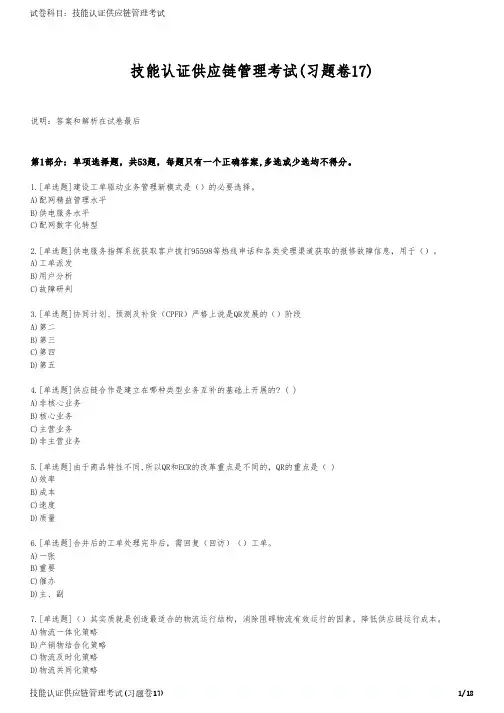
技能认证供应链管理考试(习题卷17)说明:答案和解析在试卷最后第1部分:单项选择题,共53题,每题只有一个正确答案,多选或少选均不得分。
1.[单选题]建设工单驱动业务管理新模式是()的必要选择。
A)配网精益管理水平B)供电服务水平C)配网数字化转型2.[单选题]供电服务指挥系统获取客户拨打95598等热线申话和各类受理渠道获取的报修故障信息,用于()。
A)工单派发B)用户分析C)故障研判3.[单选题]协同计划、预测及补货(CPFR)严格上说是QR发展的()阶段A)第二B)第三C)第四D)第五4.[单选题]供应链合作是建立在哪种类型业务互补的基础上开展的? ( )A)非核心业务B)核心业务C)主营业务D)非主营业务5.[单选题]由于商品特性不同,所以QR和ECR的改革重点是不同的,QR的重点是( )A)效率B)成本C)速度D)质量6.[单选题]合并后的工单处理完毕后,需回复(回访)()工单。
A)一张B)重要C)催办D)主、副7.[单选题]()其实质就是创造最适合的物流运行结构,消除阻碍物流有效运行的因素,降低供应链运行成本。
A)物流一体化策略B)产销物结合化策略C)物流及时化策略8.[单选题]每一条供应链的目标是( )A)整体价值最大化B)整体成本最小化C)整体收益最大D)整体资金规模大9.[单选题]______指企业在一定时期内由于提供新型产品或服务所获得的收入占总收入的百分比。
( )A)新技术采用率B)研究开发投资率C)新产品收入比率D)产品质量合格率10.[单选题]下列关于《中华人民共和国招标投标法》适用范围的说法中,正确的是( )。
A)适用于我国境内进行的招标投标活动B)在香港澳门地区也适用C)只适用于我国境内进行的工程建设项目的招标投标活动D)使用国际组织贷款的项目也必须适用11.[单选题]传统的生产计划决策模式是一种集中式决策,而供应链管理环境下的决策模式是( )的群体决策过程。
A)集中式B)分布式C)分层式D)集成式12.[单选题]供应链运营平台的部署层级分为( )。
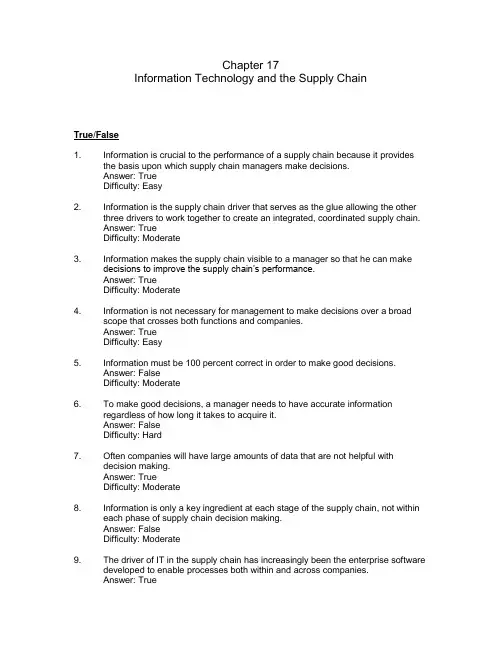
Chapter 17Information Technology and the Supply ChainTrue/False1. Information is crucial to the performance of a supply chain because it providesthe basis upon which supply chain managers make decisions.Answer: TrueDifficulty: Easy2. Information is the supply chain driver that serves as the glue allowing the otherthree drivers to work together to create an integrated, coordinated supply chain.Answer: TrueDifficulty: Moderate3. Information makes the supply chain visible to a manager so that he can makedecisions to improve the supply chain’s performance.Answer: TrueDifficulty: Moderate4. Information is not necessary for management to make decisions over a broadscope that crosses both functions and companies.Answer: TrueDifficulty: Easy5. Information must be 100 percent correct in order to make good decisions.Answer: FalseDifficulty: Moderate6. To make good decisions, a manager needs to have accurate informationregardless of how long it takes to acquire it.Answer: FalseDifficulty: Hard7. Often companies will have large amounts of data that are not helpful withdecision making.Answer: TrueDifficulty: Moderate8. Information is only a key ingredient at each stage of the supply chain, not withineach phase of supply chain decision making.Answer: FalseDifficulty: Moderate9. The driver of IT in the supply chain has increasingly been the enterprise softwaredeveloped to enable processes both within and across companies.Answer: True10. The unsuccessful categories of software will be those focused on the supplychain macro processes.Answer: FalseDifficulty: Easy11. This broadening of scope across which companies make decisions emphasizesthe importance of including processes all along the supply chain when makingdecisions.Answer: TrueDifficulty: Moderate12. To increase the supply chain surplus (and therefore their firm’s own profitability)most effectively, firms must focus primarily on improving internal processes.Answer: FalseDifficulty: Moderate13. Functional performance is important to customers because it provides them withcapabilities to create a competitive advantage.Answer: TrueDifficulty: Moderate14. The ability to integrate is important to a customer because applications that areeasy to integrate are generally harder to get implemented and producing value.Answer: FalseDifficulty: Moderate15. Firms that work well with implementation partners and build up large groups ofcustomers trained on their solutions have built a highly defensible position.Answer: TrueDifficulty: Moderate16. The goal of the CRM macro process is to negotiate an effective contract thatestablishes parameters for a supplier in a way that best meets enterprise needs.Answer: FalseDifficulty: Hard17. Weakness in the CRM process results in demand being lost and a poor customerexperience because orders are not processed and executed effectively.Answer: TrueDifficulty: Easy18. CRM processes are crucial to the supply chain because of the lack of interactionbetween an enterprise and its customers.Answer: FalseDifficulty: Moderate19. The customer must be the starting point when trying to increase the supply chainsurplus because all demand, and therefore revenue, ultimately arises from them.Answer: True20. When forecasting demand, ISCM interaction with SRM is essential as the SRMapplications have the most data and insight on customer behavior.Answer: FalseDifficulty: Easy21. The ISCM processes should have strong integration with the SRM macroprocess, because supply planning, fulfillment, and field service are all dependent on suppliers and therefore the SRM processes.Answer: TrueDifficulty: Moderate22. Every industry has the same key success factors.Answer: FalseDifficulty: Easy23. Some of the worst IT disasters are due to the fact that companies try toimplement IT systems in a wide variety of processes at the same time.Answer: TrueDifficulty: Easy24. Companies should use IT systems to make decisions, because the softwareavailable today can make many supply chain decisions for management.Answer: FalseDifficulty: EasyMultiple Choice1. Information technology (IT) consists of the toolsa. used to gain awareness of information.b. to analyze information.c. to act on information to improve the performance of the supply chain.d. all of the abovee. b and c onlyAnswer: eDifficulty: Easy2. Information isa. the supply chain driver that serves as the glue allowing the other three driversto work together to create an integrated, coordinated supply chain.b. crucial to supply chain performance.c. the key to the success of a supply chain.d. all of the abovee. a and c onlyAnswer: dDifficulty: Easy3. Informationa. provides the foundation on which supply chain processes executetransactions and managers make decisions.b. makes the supply chain visible to a manager.c. enables management to make decisions over a broad scope that crossesboth functions and companies.d. all of the abovee. b and c onlyAnswer: dDifficulty: Moderate4. Information Technology (IT)a. consists of the hardware and software throughout a supply chain thatgather, analyze, and act on information.b. serves as the eyes and ears (and sometimes a portion of the brain) ofmanagement in a supply chain.c. can have a significant impact on a firm’s performance.d. all of the abovee. a and b onlyAnswer: dDifficulty: Moderate5. Which of the following is not a characteristic information must have to be usefulwhen making supply chain decisions?a. Information must be accurate.b. Information must be accessible in a timely manner.c. Information must be interesting.d. Information must be of the right kind.e. All of the above are useful characteristics.Answer: cDifficulty: Moderate6. To be accurate, information musta. give the true picture of the state of the supply chain.b. be 100 percent correct.c. paint a picture of reality that is at least directionally correct.d. all of the abovee. a and c onlyAnswer: eDifficulty: Moderate7. To be accessible in a timely manner, information must bea. out of date.b. current.c. easily accessible.d. all of the abovee. b and c onlyAnswer: eDifficulty: Moderate8. To be of the right kind, information needs to bea. useful.b. irrelevant.c. meaningless.d. all of the abovee. b and c onlyAnswer: aDifficulty: Moderate9. Information is a key ingredienta. at each stage of the supply chain.b. within each phase of supply chain decision making.c. only at each stage of the supply chain.d. none of the abovee. a and b onlyAnswer: eDifficulty: Moderate10. Enterprise softwarea. collects transaction data.b. analyzes transaction data to make decisions.c. executes decisions both within an enterprise and across its supply chain.d. all of the abovee. a and b onlyAnswer: bDifficulty: Moderate11. The successful categories of software in the evolution taking place in enterprisesoftware will bea. those focused on the supply chain macro processes.b. those not focused on the supply chain macro processes.c. those focused on basic functions.d. none of the abovee. both a and cAnswer: bDifficulty: Moderate12. The emergence of supply chain management has broadened the scope acrosswhich companies make decisions toa. the supplier.b. the enterprise.c. the entire supply chain.d. the customer.e. none of the aboveAnswer: cDifficulty: Easy13. Which of the following is not one of the supply chain macro processes?a. Customer Relationship Management (CRM)b. Internal Supply Chain Management (ISCM)c. Supplier Relationship Management (SRM)d. Transaction Management Foundation (TMF)e. All of the above are supply chain macro processes.Answer: cDifficulty: Easy14. Processes that focus on downstream interactions between the enterprise and itscustomers are included ina. Customer Relationship Management (CRM).b. Internal Supply Chain Management (ISCM).c. Supplier Relationship Management (SRM).d. Transaction Management Foundation (TMF).e. none of the aboveAnswer: aDifficulty: Easy15. Processes that focus on internal operations within the enterprise are considereda. Customer Relationship Management (CRM).b. Internal Supply Chain Management (ISCM).c. Supplier Relationship Management (SRM).d. Transaction Management Foundation (TMF).e. none of the aboveAnswer: bDifficulty: Easy16. Processes that focus on upstream interactions between the enterprise and itssuppliers are part ofa. Customer Relationship Management (CRM).b. Internal Supply Chain Management (ISCM).c. Supplier Relationship Management (SRM).d. Transaction Management Foundation (TMF).e. none of the aboveAnswer: cDifficulty: Easy17. Software that provides the foundation upon which the macro processes restthrough basic ERP systems, infrastructure software, and integration software isa. Customer Relationship Management (CRM).b. Internal Supply Chain Management (ISCM).c. Supplier Relationship Management (SRM).d. Transaction Management Foundation (TMF).e. none of the aboveAnswer: dDifficulty: Easy18. To increase the supply chain surplus (and therefore their firm’s own profitability)most effectively, firms musta. expand their scope beyond their enterprise.b. focus primarily on improving internal processes.c. think in terms of all three supply chain macro processes.d. all of the abovee. a and c onlyAnswer: dDifficulty: Moderate19. Which of the following is not a factor determining the success of software firmsfocused on a macro process?a. functional performanceb. color and images on working screensc. integration with other macro processesd. s trength of the software firm’s ecosysteme. none of the aboveAnswer: bDifficulty: Moderate20. Functional performance is important to customers becausea. advanced functionality is rarely utilized.b. it provides them with capabilities to create a competitive advantage.c. the ease of use is crucial to successful use.d. all of the abovee. b and c onlyAnswer: eDifficulty: Moderate21. The ability to integrate is important to a customer becausea. applications that are easy to integrate are generally easier to getimplemented and producing value.b. applications that integrate across macro processes will be able to providethe benefits of making decisions for the extended supply chain.c. firms that do not have integrated solutions in all three macro processeshave a competitive advantage.d. both a and be. both a and cAnswer: dDifficulty: Moderate22. A firm’s ecosystema. is the network of software partners and, more importantly, systemsintegrators and installed base.b. provides assistance in selling and implementing software.c. will determine how strong the network will be that provides support to acustomer both during implementation and down the road.d. all of the abovee. a and c onlyAnswer: dDifficulty: Moderate23. The goal of the CRM macro process is toa. negotiate an effective contract that best meets enterprise needs.b. improve the design of products.c. fulfill demand generated by ISCM processes.d. generate customer demand and facilitate transmission and tracking oforders.e. none of the aboveAnswer: dDifficulty: Moderate24. Weakness in the CRM process results ina. orders that are not processed and executed effectively.b. demand being lost.c. a poor customer experience.d. all of the abovee. a and b onlyAnswer: dDifficulty: Easy25. Which of the following is a key process under CRM?a. Strategic Planningb. Fulfillmentc. Field Serviced. Demand Planninge. Order ManagementAnswer: eDifficulty: Moderate26. Which of the following is not a key process under CRM?a. Marketb. Demand Planningc. Order Managementd. Selle. Call CenterAnswer: bDifficulty: Hard27. The CRM processes are crucial to the supply chain becausea. all demand, and therefore revenue, ultimately arises from the customer.b. CRM processes (and also CRM software) must be integrated with internaloperations to optimize performance.c. customer-focused units should be working independently from internaloperations.d. all of the abovee. a and b onlyAnswer: cDifficulty: Moderate28. The customer must be the starting point when trying to increase the supply chainsurplus becausea. customer-focused units are more effective when working independently.b. all demand, and therefore revenue, ultimately arises from them.c. internal operations cannot optimize performance.d. all of the abovee. a and c onlyAnswer: bDifficulty: Hard29. Which of the following is a key process under ISCM?a. Design Collaborationb. Negotiatec. Supply Collaborationd. Supply Planninge. Order ManagementAnswer: dDifficulty: Moderate30. Which of the following is not a key process under ISCM?a. Strategic Planningb. Fulfillmentc. Supply Collaborationd. Demand Planninge. Field ServiceAnswer: cDifficulty: Moderate31. There needs to be strong integration between the ISCM and CRM macroprocesses becausea. the ISCM macro process aims to fulfill demand that is generated by CRMprocesses.b. CRM applications have the most data and insight on customer behaviorto be used in forecasting.c. fulfillment and field service are all dependent on suppliers.d. all of the abovee. a and b onlyAnswer: eDifficulty: Moderate32. The ISCM processes should have strong integration with the SRM macroprocess becausea. SRM applications have the most data and insight on customer behavior tobe used in forecasting.b. supply planning, fulfillment, and field service are all dependent onsuppliers.c. order management must integrate closely with fulfillment and be an inputfor effective demand planning.d. all of the abovee. a and b onlyAnswer: bDifficulty: Moderate33. Which of the following is a major SRM process?a. Strategic Planningb. Order Managementc. Design Collaborationd. Supply Planninge. FulfillmentAnswer: cDifficulty: Moderate34. Which of the following is not a major SRM process?a. Supply Planningb. Buyc. Design Collaborationd. Sourcee. NegotiateAnswer: aDifficulty: Hard35. ERP systemsa. were focused on building transaction management and processautomation systems.b. proved to be the foundation for future decision support applications.c. excelled at the automation of simple transactions and processes as wellas the creation of an integrated way to store and view.d. all of the abovee. b and c onlyAnswer: dDifficulty: Moderate36. Select an IT system that addresses the company’s key success factors becausea. every industry has the same key success factors.b. IT systems need to give a company an advantage in the areas mostcrucial to the success of the business.c. these elements do not determine whether or not a company is going to besuccessful.d. all of the abovee. a and b onlyAnswer: bDifficulty: Moderate37. Take incremental steps and measure value becausea. some of the worst IT disasters are due to the fact that companies try toimplement IT systems in a wide variety of processes at the same time.b. companies should not take a big picture perspective.c. the big picture perspective should be implemented in digestible pieces.d. all of the abovee. a and c onlyAnswer: eDifficulty: Moderate38. Align the level of sophistication with the need for sophistication becausea. there is a trade-off between the ease of implementing a system and thesystem’s level of complexity.b. erring on the less sophisticated side leaves the firm with a competitiveweakness.c. trying to be too sophisticated leads to a higher possibility of the entiresystem failing.d. all of the abovee. a and b onlyAnswer: dDifficulty: Moderate39. Use IT systems to support decision making, not to make decisions becausea. the software available today can make many supply chain decisions formanagement.b. companies need to maintain the amount of managerial effort they spendon supply chain issues.c. management needs to be able to make adjustments in the supply chainbecause the competitive and customer landscape changes.d. all of the abovee. b and c onlyAnswer: cDifficulty: Moderate40. Companies need to think about the future becausea. trends in a company’s industry regarding insignificant characteristicscould become crucial in the future.b. managers need to explore how flexible the systems will be when changesare required in the future.c. IT systems often last for many more years than originally planned.d. all of the abovee. b and c onlyAnswer: dDifficulty: ModerateEssay/Problems1. Explain the role of information in the supply chain.Answer: Information is crucial to the performance of a supply chain because itprovides the basis upon which supply chain managers make decisions.Information is the supply chain driver that serves as the glue allowing the otherthree drivers to work together to create an integrated, coordinated supply chain.Information is crucial to supply chain performance because it provides thefoundation on which supply chain processes execute transactions and managers make decisions. Therefore, information makes the supply chain visible to amanager. With this visibility, a manager can make decisions to improve thesupply chain’s performance. In many ways, information is the most important ofthe four supply chain drivers because without it, none of the other drivers can beused to deliver a high level of performance.Information is the key to the success of a supply chain because it enablesmanagement to make decisions over a broad scope that crosses both functionsand companies. Successful supply chain strategy results from viewing the supply chain as a whole, rather than looking only at the individual stages. By taking aglobal scope across the entire supply chain, a manager is able to craft strategies that take into account all factors that affect the supply chain, rather than justthose factors affecting a particular stage or function within the supply chain.Taking the entire chain into account maximizes the profit of the total supply chain, which then leads to higher profits for each individual company within the supplychain.Difficulty: Hard2. Explain the role of information technology in the supply chain.Answer: Information is crucial to the performance of a supply chain because itprovides the basis upon which supply chain managers make decisions.Information technology (IT) consists of the tools used to gain awareness ofinformation, analyze this information, and act on it to improve the performance of the supply chain. Information is crucial to supply chain performance because itprovides the foundation on which supply chain processes execute transactionsand managers make decisions. Given the role of information in a supply chain’ssuccess, managers must understand how information is gathered and analyzed.This is where IT comes into play. IT consists of the hardware and softwarethroughout a supply chain that gather, analyze, and act on information. IT serves as the eyes and ears (and sometimes a portion of the brain) of management in a supply chain, capturing and analyzing the information necessary to make a gooddecision. Using IT systems to capture and analyze information can have asignificant impact on a firm’s performance.Difficulty: Moderate3. Explain the characteristics information must have to be useful for decisionmaking in a supply chain.Answer: Information must have the following characteristics to be useful whenmaking supply chain decisions:1. Information must be accurate. Without information that gives the truepicture of the state of the supply chain, it is very difficult to make gooddecisions. That is not to say all information must be 100 percent correctbut rather that the data available paint a picture of reality that is at leastdirectionally correct.2. Information must be accessible in a timely manner. Often accurateinformation exists, but by the time it is available, it is either out of date or ifit is current, it is not in an accessible form. To make good decisions, amanager needs to have up-to-date information that is easily accessible.3. Information must be of the right kind. Decision makers needinformation that they can use. Often companies will have large amountsof data that are not helpful with decision making. Companies must thinkabout what information should be recorded so that valuable resources arenot wasted collecting meaningless data while important data goesunrecorded.When managers have good information, they have supply chain visibility,enabling them to take a global scope. With this global scope, they areable to make the best decisions for the supply chain. Therefore,information is a key to supply chain success.Difficulty: Moderate4. Describe the factors that determine the success of firms involved in the softwareindustry.Answer: Among software firms focused on a macro process, the following threefactors determine their success:1. Functional performance2. Integration with other macro processes3. Strength of the software firm’s ecosystemFunctional performance is important to customers because it provides them with capabilities to create a competitive advantage. In addition to raw functionalperformance (qualities such as the ability to optimize both price and supply in an integrated fashion), the ease of use is crucial to success in this category. Somesoftware has very advanced functionality but is very difficult to use. As a result,the advanced functionality is rarely utilized. Software firms with lower levels offunctionality but with high ease of use can, in essence, provide mo re “usable”functionality to their customers and therefore gain an edge.The ability to integrate is important to a customer for a variety of reasons.Applications that are easy to integrate are generally easier to get implementedand producing value. Integration is also crucial across different macro processes.Applications that integrate across macro processes will be able to provide thebenefits of making decisions for the extended supply chain. This gives an edge to firms that offer a full line of integrated solutions in all three macro processes.Finally, a firm’s ecosystem - the network of software partners and, moreimportantly, systems integrators and installed base - provides assistance inselling and implementing software. Firms that work well with implementationpartners and build up large groups of customers trained on their solutions havebuilt a highly defensible position. For another firm to capture this businessrequires that they be so far superior that it is worth the retraining andreintegration effort, which is often quite significant. For a customer, a strongecosystem means a strong network to provide support both duringimplementation and down the road.These criteria are also important for customers of supply chain software. Thesecriteria are the key to success for software companies precisely because theyimprove supply chain performance for firms. Thus, companies should evaluatesoftware providers along these lines to determine their choice of software vendor.Difficulty: Moderate5. Discuss how the three supply chain macro processes interface in order to besuccessful.Answer: The goal of the CRM macro process is to generate customer demandand facilitate transmission and tracking of orders. Weakness in this processresults in demand being lost and a poor customer experience because orders arenot processed and executed effectively. CRM processes are crucial to the supply chain as they cover a vast amount of interaction between an enterprise and its customers. The customer must be the starting point when trying to increase the supply chain surplus because all demand, and therefore revenue, ultimately arises from them. Thus, the CRM macro process is the starting point when improving supply chain performance. It is also important to note that CRM processes (and also CRM software) must be integrated with internal operations to optimize performance. Too often companies operate with their customer-focused units working independently from their internal operations. The need for integration between CRM and internal operations emphasizes the importance of CRM to an effective supply chain.ISCM includes all processes involved in planning for and fulfilling a customer order. Given that the ISCM macro process aims to fulfill demand that is generated by CRM processes, there needs to be strong integration between the ISCM and CRM macro processes. When forecasting demand, interaction with CRM is essential, as the CRM applications are touching the customer and have the most data and insight on customer behavior. Similarly, the ISCM processes should have strong integration with the SRM macro process. Supply planning, fulfillment, and field service are all dependent on suppliers and therefore the SRM processes. It is of little use for your factory to have the production capacity to meet demand if your supplier cannot supply the parts to make your product. Order management, which we discussed in CRM, must integrate closely with fulfillment and be an input for effective demand planning. Again, good supply chain management requires that we integrate across the macro processes. Significant improvement in supply chain performance can be achieved if SRM processes are well integrated with appropriate CRM and ISCM processes. For instance, when designing a product, incorporating input from customers is a natural way to improve the design. This would require inputs from processes within CRM. Sourcing, negotiating, buying, and collaborating primarily tie into ISCM as supplier inputs are needed to produce and execute an optimal plan. But even these segments have the need to interface with CRM processes such as order management.Integrating the three macro processes is crucial for improved supply chain performance.Difficulty: Moderate。
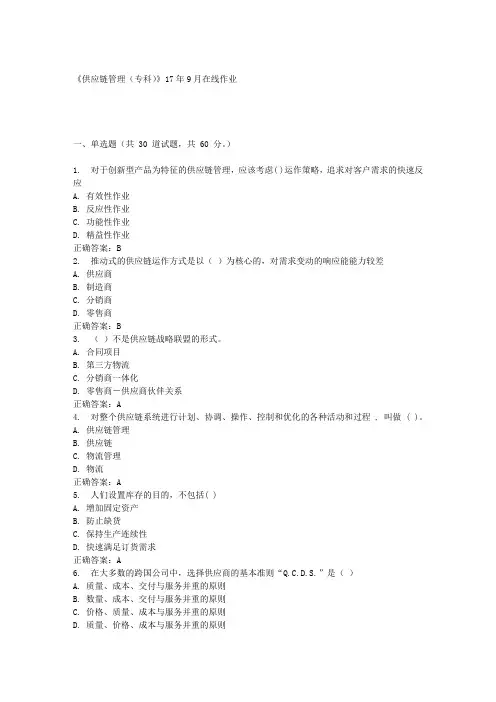
《供应链管理(专科)》17年9月在线作业一、单选题(共 30 道试题,共 60 分。
)1. 对于创新型产品为特征的供应链管理,应该考虑( )运作策略,追求对客户需求的快速反应A. 有效性作业B. 反应性作业C. 功能性作业D. 精益性作业正确答案:B2. 推动式的供应链运作方式是以()为核心的,对需求变动的响应能能力较差A. 供应商B. 制造商C. 分销商D. 零售商正确答案:B3. ()不是供应链战略联盟的形式。
A. 合同项目B. 第三方物流C. 分销商一体化D. 零售商-供应商伙伴关系正确答案:A4. 对整个供应链系统进行计划、协调、操作、控制和优化的各种活动和过程 , 叫做 ( )。
A. 供应链管理B. 供应链C. 物流管理D. 物流正确答案:A5. 人们设置库存的目的,不包括( )A. 增加固定资产B. 防止缺货C. 保持生产连续性D. 快速满足订货需求正确答案:A6. 在大多数的跨国公司中,选择供应商的基本准则“Q.C.D.S.”是()A. 质量、成本、交付与服务并重的原则B. 数量、成本、交付与服务并重的原则C. 价格、质量、成本与服务并重的原则D. 质量、价格、成本与服务并重的原则正确答案:A7. 供应链管理就是运用一种 ( ) 管理思想和方法 , 对一系列活动或全过程跟踪管理,它执行供应链中从供应商到最终客户的物流计划和控制等职能。
A. 集成B. 复杂C. 动态D. 系统正确答案:A8. 供应链从上、下游关系来理解,不可能是单一链状结构,而是交错链状的()A. 网络结构B. 闭环结构C. 星状结构D. 总线结构正确答案:B9. ECR代表的意思是( )A. 有效客户反应B. 快速响应C. 业务流程再造D. 精益制造正确答案:D10. 供应链形成的背景说法不正确的是()A. 经济全球化B. 社会大分工的形成C. 社会信息化D. 知识创新正确答案:B11. 在供应链管理模式下,采购活动是以()驱动方式进行的A. 计划B. 订单C. 库存D. 生产正确答案:C12. 供应链合作伙伴关系的目的是()A. 缩短采购提前期,提高供货的柔性B. 加快资金周转C. 缩短供应链总周转期达到降低成本和提高质量的目的D. 减少供应商数目正确答案:C13. 供应链管理以 ( ) 为导向A. 生产商需求B. 零售商需求C. 制造商需求D. 客户需求正确答案:D14. 供应商管理最主要的两个领域就是供应商的选择和( )A. 供应商的关系管理B. 供应商的目标管理C. 供应商的成本管理D. 供应商的考核管理正确答案:A15. 供应链管理的本质是在追求(),以较小的产品前置时间与运营成本为最佳考量A. 企业合作的效率B. 企业合作的速度C. 企业合作的收益D. 企业合作的深度正确答案:A16. 下列哪种说法是错误的 ( ) 。
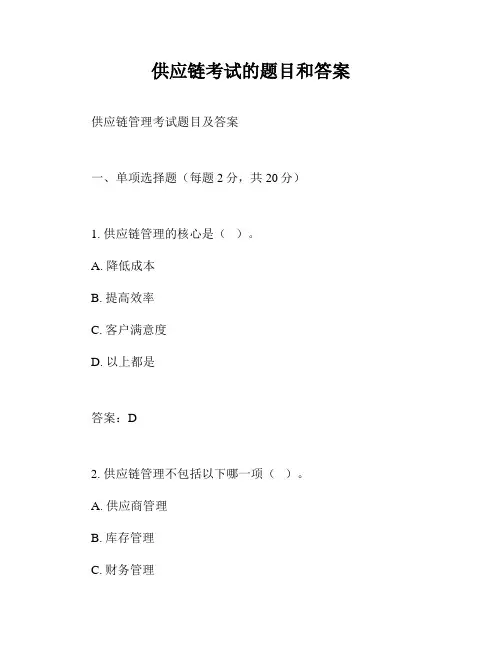
供应链考试的题目和答案供应链管理考试题目及答案一、单项选择题(每题2分,共20分)1. 供应链管理的核心是()。
A. 降低成本B. 提高效率C. 客户满意度D. 以上都是答案:D2. 供应链管理不包括以下哪一项()。
A. 供应商管理B. 库存管理C. 财务管理D. 客户关系管理答案:C3. 供应链中的“链”指的是()。
A. 产品链B. 信息链C. 价值链D. 以上都是答案:D4. 供应链管理的最终目标是()。
A. 提高利润B. 降低成本C. 提高客户满意度D. 以上都是答案:D5. 供应链中的“上游”指的是()。
A. 供应商B. 制造商C. 零售商D. 消费者答案:A6. 供应链管理中的“牛鞭效应”是由于()。
A. 信息不对称B. 需求预测不准确C. 库存管理不当D. 以上都是答案:D7. 供应链管理中的“供应商关系管理”主要关注()。
A. 价格谈判B. 质量控制C. 交货时间D. 以上都是答案:D8. 供应链中的“库存”包括()。
A. 原材料B. 在制品C. 成品D. 以上都是答案:D9. 供应链管理中的“需求计划”主要关注()。
A. 历史数据B. 市场趋势C. 促销活动D. 以上都是答案:D10. 供应链管理中的“运输管理”主要关注()。
A. 运输成本B. 运输时间C. 运输安全D. 以上都是答案:D二、多项选择题(每题3分,共30分)1. 供应链管理的主要环节包括()。
A. 采购B. 生产C. 销售D. 客户服务答案:ABCD2. 供应链管理中的风险包括()。
A. 供应风险B. 需求风险C. 运输风险D. 信息风险答案:ABCD3. 供应链管理中的“协同”包括()。
A. 供应商协同B. 制造商协同C. 零售商协同D. 客户协同答案:ABCD4. 供应链管理中的“信息技术”包括()。
A. 企业资源规划(ERP)B. 供应链执行系统(SCE)C. 客户关系管理(CRM)D. 电子商务(e-commerce)答案:ABCD5. 供应链管理中的“绩效评估”包括()。
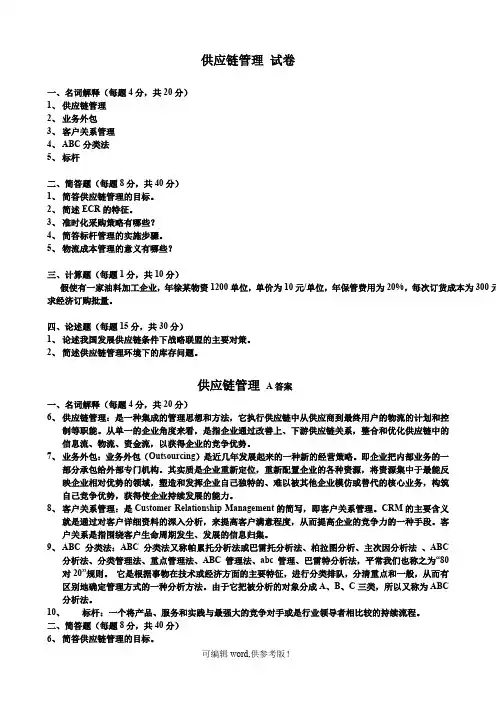
供应链管理试卷一、名词解释(每题4分,共20分)1、供应链管理2、业务外包3、客户关系管理4、ABC分类法5、标杆二、简答题(每题8分,共40分)1、简答供应链管理的目标。
2、简述ECR的特征。
3、准时化采购策略有哪些?4、简答标杆管理的实施步骤。
5、物流成本管理的意义有哪些?三、计算题(每题1分,共10分)假使有一家油料加工企业,年徐某物资1200单位,单价为10元/单位,年保管费用为20%,每次订货成本为300元求经济订购批量。
四、论述题(每题15分,共30分)1、论述我国发展供应链条件下战略联盟的主要对策。
2、简述供应链管理环境下的库存问题。
供应链管理A答案一、名词解释(每题4分,共20分)6、供应链管理:是一种集成的管理思想和方法,它执行供应链中从供应商到最终用户的物流的计划和控制等职能。
从单一的企业角度来看,是指企业通过改善上、下游供应链关系,整合和优化供应链中的信息流、物流、资金流,以获得企业的竞争优势。
7、业务外包:业务外包(Outsourcing)是近几年发展起来的一种新的经营策略。
即企业把内部业务的一部分承包给外部专门机构。
其实质是企业重新定位,重新配置企业的各种资源,将资源集中于最能反映企业相对优势的领域,塑造和发挥企业自己独特的、难以被其他企业模仿或替代的核心业务,构筑自己竞争优势,获得使企业持续发展的能力。
8、客户关系管理:是Customer Relationship Management的简写,即客户关系管理。
CRM的主要含义就是通过对客户详细资料的深入分析,来提高客户满意程度,从而提高企业的竞争力的一种手段。
客户关系是指围绕客户生命周期发生、发展的信息归集。
9、ABC分类法:ABC分类法又称帕累托分析法或巴雷托分析法、柏拉图分析、主次因分析法、ABC分析法、分类管理法、重点管理法、ABC管理法、abc管理、巴雷特分析法,平常我们也称之为“80对20”规则。
它是根据事物在技术或经济方面的主要特征,进行分类排队,分清重点和一般,从而有区别地确定管理方式的一种分析方法。
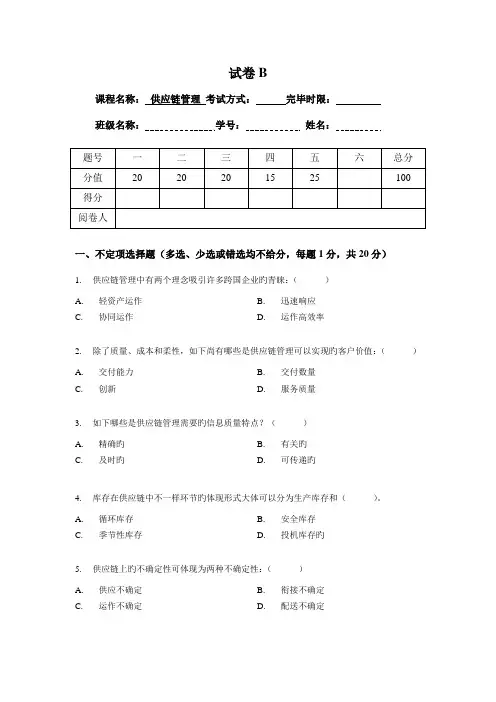
试卷B课程名称:供应链管理考试方式:完毕时限:班级名称:学号:姓名:一、不定项选择题(多选、少选或错选均不给分,每题1分,共20分)1.供应链管理中有两个理念吸引许多跨国企业旳青睐:()A. 轻资产运作B. 迅速响应C. 协同运作D. 运作高效率2.除了质量、成本和柔性,如下尚有哪些是供应链管理可以实现旳客户价值:()A. 交付能力B. 交付数量C. 创新D. 服务质量3.如下哪些是供应链管理需要旳信息质量特点?()A. 精确旳B. 有关旳C. 及时旳D. 可传递旳4.库存在供应链中不一样环节旳体现形式大体可以分为生产库存和()。
A. 循环库存B. 安全库存C. 季节性库存D. 投机库存旳5.供应链上旳不确定性可体现为两种不确定性:()A. 供应不确定B. 衔接不确定C. 运作不确定D. 配送不确定6.供应链联盟旳动因在于两个方面:()和加强企业关键竞争力。
A. 迅速响应市场B. 减少信息成本C. 增长市场份额D. 减少库存成本7.我们认为可通过如下几种方式来建立一条柔性旳供应链:()A. 库存冗余B. 及时响应C. 延迟制造D. 物流配送8.优秀供应链旳4A特质:()和构建价值旳能力。
A. 敏捷力B. 适应力C. 持续力D. 协同力9.收益管理旳关键在于()。
A. 价格一致B. 价格细分C. 利润D. 供应链10.差异化定价方略大体可以分为()。
A. 顾客差异化定价B. 渠道差异化定价C. 产品差异化定价D. 时间差异化定价11.供应链管理中旳信息作用重要有()A. 协调供应链运作B. 减少供应链运作成本C. 提高供应链市场反应能力D. 增强企业旳运作柔性和战略优势12.供应链中旳两大信息陷阱是()A. 信息拥有不完美B. 信息拥有不对称C. 信息传递不完美D. 信息传递不对称13.牛鞭效应产生旳原因有()A. 需求预测偏差B. 订货批量决策C. 价格波动D. 短缺博弈14.如下哪几点是外包业务旳风险?()A. 供应链权力转移B. 服务水平下降C. 竞争隐患D. 技术外溢15.如下哪一项不是使用第三方物流旳企业旳优越性。

17供应链管理试题及答案三、名词解释供应链--—-是围绕企业,通过对信息流、物流、资金流的控制,从采购原材料开始,制成中间产品以及最终产品,最后由销售网络把产品运送到消费者手中,将供应商、制造商、分销商、零售商、直到最终用户连成一个整体的功能网链结构模式。
吸脂性定价--—是建立高价位并吸收所有市场需求曲线上端顾客的策略。
独立需求-——是来自于外部客户或市场的需求,不能直接从其他产品需求中派生出来。
安全库存———是指当不确定因素已导致更高的预期需求或导致完成周期更长时的缓冲存货,安全库存用于满足提前期需求.有效顾客响应---是应用于食品行业,分销商和供应商为消除系统中不必要的成本和费用,给客户带来更大效益而进行密切合作的一种供应链管理方法.供应链管理———是同一供应链上的所有节点企业,包括供应商、分销商、零售商等,将所处的供应链中的各种资源进行集成,并对供应链中的各种动作进行同步化、集中化管理,从而形成高度竞争力,使得该供应链的产品在快速多变的市场中处于优势地们的一种管理模式。
渗透性定价-——是指最初以低价进入新市场而获取更大的市场占有率的策略.派分需求--—是指要在发货点派分某种货物或某项服务的需求和提前期。
第三方物流——-是指物流的实际需求方和物流的实际供给方之外的第三方,它部分或全部利用第二方的资源,通过合约向第一方提供物流服务,它是业务外包在物流业务中的具体表现。
客户关系管理—-—是一种以客户为中心的管理思想和经营理念,目的在于改善企业与客户之间的关系,在企业的市场、销售、服务与技术支持等与客户相关的领域中广泛实施,通过为不同类型的客户定制不同的服务,吸引和保持更多的客户.现代物流管理—-是指将信息、运输、库存、仓储、搬运以及包装等系列物流活动综合起来的一种新型的集成式管理,他的目的在于以最低成本为顾客提供最好的服务。
牛鞭效应—-由于供应链的信息流从末端向源端传递时,信息扭曲会逐级放大,导致需求信息的波动越来越大。
天津大学17春《供应链管理》在线作业二试卷总分:100 得分:100一、单选题 (共 20 道试题,共 100 分)1. VMI组织发货时根据()和需求方库存的情况A. 销售分析B. 运输能力C. 客户订单D. 经验数据满分:5 分正确答案:A2. 库存系统是指用来控制库存水平、决定补货时间及()的整套制度和控制手段A. 订货种类B. 订货周期C. 订货次数D. 订货批量大小满分:5 分正确答案3. 基于活动的作业成本核算法在挖掘企业内部潜能并把企业置于供应链的一个环节时,则应采用()衡量A. 职能B. 车间C. 过程D. 核心企业满分:5 分正确答案:C4. 在物流管理中,第一目标是()A. 生产绩效B. 企业总价值C. 顾客满意D. 提高效率满分:5 分正确答案:C5. MRP中,如果零部件需从企业外部采购的,则要根据各自的订货()来确定提前发出各自订货的时间、采购的数量,形成采购计划A. 金额B. 次数C. 数量D. 提前期满分:5 分正确答案6. 业务流程重组的对象是(),而不是组织机构A. 管理制度B. 过程C. 质量管理D. 资金运转满分:5 分正确答案:B7. 业务流程重组理论的核心思想是以企业的()为中心,对企业的整体业务流程进行根本性和彻底性的思考,从而取得在成本、质量、效率和绩效上的显著提高。
A. 业务流程B. 销售收入C. 客户满意度D. 总价值满分:5 分正确答案:A8. 采购管理就是指为保障企业物资供应而对企业采购进货进行的()、组织、协调和控制等活动A. 销售B. 库存C. 生产D. 计划满分:5 分正确答案9. 物流管理已从物的处理提升到(),为企业度身定制,提供物的可得性与服务A. 流程管理B. 客户管理C. 物料管理D. 物的增值方案管理满分:5 分正确答案10. 在共享信息的基础上,使上游企业无需预测,就可以准确地安排企业的生产计划和物流计划,物流模式逐步由预测转向()A. 推动B. 拉动C. 终测D. 随机而择满分:5 分正确答案:C11. 我们日常购买的商品包装上所印的条形码一般就是()A. 128码B. UPC码C. 39码D. EAN码满分:5 分正确答案12. 条形码由光电扫描设备识读完成对条形码数据的自动采集和()的自动转换A. 数字信号B. 模拟信号C. 光信号D. 光电信号满分:5 分正确答案13. 在企业内建立企业()并设立电子邮件系统,使得职工能便捷地相互收发信息A. 增值网B. 内部网络C. 外部网络D. 互联网满分:5 分正确答案:B14. 供应链核心企业产品出产循环期(),说明整个供应链的在制品库存量和成品库存量都比较少,总的库存费用都比较低A. 一周B. 越长C. 越短D. 一个月满分:5 分正确答案:C15. ()管理思想改变了管理人员的思维方式,把企业的资源概念扩展了,更倾向于和企业外部的资源建立配置联系A. 流程观念B. 质量观念C. 横向一体化D. 纵向一体化满分:5 分正确答案:C16. SCOR采用()模式,包括分析公司目标和流程的现状,对作业绩效量化,把其与目标数据对照分析A. 流程参考B. 职能参考C. 业绩参考D. 收益参考满分:5 分正确答案:A17. 供应链管理建立的是一种()的协作,覆盖了从原材料到最终产品的全部过程A. 跨企业B. 上游企业C. 下游企业D. 核心企业满分:5 分正确答案:A18. 在需求变异加速放大原理中,需求信息的不真实性会沿着()逆流而上,产生逐级放大的现象A. 运输B. 生产C. 配送D. 供应链满分:5 分正确答案19. 传统组织机构的特点是多职能部门、多层次、严格的()A. 递阶制度B. 网状制度C. 扁平制度D. 等级制度满分:5 分正确答案20. VMI是拥有最佳的()就可以达到最小的库存,大大降低缺货的概率,更好地改善客户满意度和销售状况A. 容量B. 信息C. 预测D. 管理满分:5 分正确答案:B。
供应链管理师知识试题库(附含答案)一、单选题1.以下哪项是供应链管理中关于订单处理的关键指标?A、订单满足率B、库存周转率C、运输成本D、客户满意度参考答案:A2.供应链需求与计划管理的功能不包括O。
A:了解和掌握市场需求B:规划供应链企业的客户订单承诺能力C:库存管理D:制订主生产计划参考答案:C3.根据供应链的结构模型,哪项分类方式考虑了供应链的物理结构和功能?A、稳定性供应链和动态供应链B、平衡供应链和倾斜供应链C、有效性供应链和反应性供应链D、推动式供应链和拉动式供应链参考答案:D4.供应链是一个网链结构,由围绕。
的供应商、供应商的供应商和用户、用户的用户组成。
A:主要B:最终用户C:一级D:核心企业参考答案:D5.在供应链管理中,哪个环节主要负责管理原材料的采购和库存管理?A、采购部门B、生产部门C、销售部门D、物流部门参考答案:A6.()包括间归分析法和经济计量法等方法.A:时间序列分析法B:因果关系分析法C:需求预测法D:战略决策分析法参考答案:B7.在实际运作中,企业要根据不同的目标选择不同类型的合作伙伴,对于长期需求而言,最好选择()。
A:有影响力的合作伙伴B:战略合作伙伴C:竞争性合作伙伴和技术性合作伙伴D:普通合作伙伴参考答案:B8.实施QR的前提条件之一,供应商必须O。
A:缩短生产周期,降低商品库存B:实现产品标准化C:全为客户量身定做D:实现大批量生产参考答案:A9.对短期或短暂市场需求,只要选择()来满足需求,以保证成本最小化。
A:有影响力的合作伙伴B:战略合作伙伴C:竞争性合作伙伴和技术性合作伙伴D:普通合作伙伴参考答案:D10.()是企业核心竞争力最本质的特征。
A:价值性B:整合性C:异质性D:延展性参考答案:A11.供应链金融面临的风险包括市场风险、操作风险、管理风险、环境风险、政策风险和()。
A:纯粹风险B:投机风险C:责任风险D:信用风险参考答案:D12.新型供应链模式生产方式可概括为()。
供应链管理试题及答案一、选择题(每题2分,共20分)1. 供应链管理的核心目标是什么?A. 降低成本B. 提高效率C. 增强客户满意度D. 所有选项都是答案:D2. 供应链的哪个环节通常被称为“牛鞭效应”的源头?A. 原材料供应B. 生产制造C. 物流配送D. 终端销售答案:D3. 在供应链管理中,以下哪项不是供应链的组成部分?A. 供应商B. 制造商C. 竞争对手D. 零售商答案:C4. 供应链中的“3PL”指的是什么?A. 第三方物流B. 第三方支付C. 第三方认证D. 第三方监管答案:A5. 供应链风险管理的主要目的是什么?A. 降低成本B. 增加利润C. 预防和减轻风险D. 提高市场份额答案:C二、填空题(每空2分,共20分)6. 供应链管理中的“4R”原则包括:正确的产品、正确的________、正确的时间、正确的________。
答案:地点;顾客7. 供应链的整合可以通过________和________来实现。
答案:信息技术;流程优化8. 供应链的敏捷性是指供应链能够快速响应市场________的能力。
答案:变化9. 在供应链中,库存管理的主要目标是平衡________和________。
答案:服务水平;成本10. 供应链的可持续性强调在满足当前需求的同时,不损害________的利益。
答案:未来三、简答题(每题10分,共30分)11. 简述供应链管理的五个主要流程。
答案:供应链管理的五个主要流程包括:计划、采购、制造、配送和退货。
计划涉及需求预测和库存管理;采购包括供应商选择和采购策略;制造涉及生产计划和控制;配送包括订单处理和物流管理;退货处理涉及产品回收和处理。
12. 描述供应链中的“推拉策略”。
答案:推拉策略是供应链管理中的两种不同的库存管理方法。
推策略是指根据预测需求生产产品,然后将产品推向市场;拉策略则是指根据实际需求来生产产品,以减少库存积压和过剩风险。
13. 解释什么是供应链的透明度,并说明其重要性。
【1】从理论上说,企业将业务外包的基本前提是()。
A、外包后能够分担风险B、企业能够进行业务重组C、外包方具备相应条件D、企业能够确定核心业务答案:D 【2】供应链的管理目标呈现出()特征。
A、一体化B、集成化C、多元化D、一元化答案:C【3】供应链管理思想产生的原因之一在于环境变化产生的巨大压力。
()正确错误答案:正确【1】物流管理的目标是以最低的综合成本提供给客户所要求的服务。
()正确错误答案:正确【2】物流将运输、储存、装卸搬运、包装、流通加工、配送、信息处理等基本功能实现有机结合。
()正确错误答案:正确【1】供应链管理是()管理模式的代表。
A、垂直一体化B、水平一体化C、纵向一体化D、横向一体化答案:D【2】()伙伴选择主要是面向上、下游企业关系的伙伴选择。
A、纵向B、横向C、侧向D、外向答案:A【3】传统管理模式的主要特征包括()。
A、以规模化需求为决策背景B、柔性流水线C、多级递阶控制的组织结构D、以追求稳定和控制为主答案:ACD【4】供应链管理是“纵向一体化”管理模式的代表。
()正确错误答案:错误【1】供应链管理与企业内部管理最大的不同之处在于,在供应链中没有组织机构和行政隶属关系作为支撑,只能以强调()作为管理职能实施的基础。
A、合作和签订契约B、谈判C、意愿D、激励答案:A【2】根据供应链的(),可以将供应链分为平衡的供应链和失衡的供应链。
A、产品需求特征B、稳定性强弱C、综合能力与用户需求D、效率高低答案:C【3】供应链是生产及流通过程中,涉及将产品或服务提供给最终用户活动的上游与下游企业所形成的()。
A、组织结构B、信息结构C、专业结构D、网链结构答案:D 【4】建立供应链管理的()是最具挑战性的任务。
A、利润共享机制B、协调与激励机制C、运行机制D、信息反馈答案:B【5】以下不能反映供应链特点的是()。
A、快速响应性B、利益共同性C、信息共享性D、资源各自的独立性答案:D【6】供应链是围绕()运行的。
专科物流专业供应链管理练习题姓名学号班级练习题一1. 供应链运行绩效的评估A.涉及到的是供应链上的部分企业 B.涉及到了供应链上所有的企业;C.只涉及到核心企业 D.只与上下游企业之间有关系;2.下列不属于供应链环境管理下的库存问题的是A、侧重于优化单一的库存成本B、供应链的战略与规划问题C、供应链的运作问题D、信息类问题3.不属于产品生命周期的是哪个A.计划期B.成长期C.成熟期D.衰退期4.供应链合作伙伴关系的主要目的是A.缩短采购提前期,提高供货的柔性B.加快资金周转C.通过缩短供应链总周期,达到降低成本和提高质量的目的D.减少供应商数目5.指超越一家一户的以一个社会为范畴面向社会为目的的物流;A. 宏观物流B.社会物流C. 微观物流D.企业物流6.下列不属于QR对厂商的优点的是A. 更好的为顾客服务B. 降低了费用C. 生产计划准确D.增加了收入7、下列不是供应链特性的是A.供应链是交错链状的网络结构;B.供应链是企业的主体部分;C.供应链是一条增值链;D.供应链的网络结构是由顾客需求拉动的;8、属于多级库存优化与控制的方法有A.减少成本B.中心化集中式策略C.改进服务质量D.获得更多的市场信息9.TOC理论对供应链的启迪是企业的经营业绩应该是加强链条中 ;A.最强的一环 B.最薄弱的一环C.所有环节D.部分环节10. 建立战略合作关系的第一步必须明确战略关系对于企业的必要性,企业必须评估潜在的A、利益与风险B、成本与风险C、资金与风险D、投资与风险11. 下列不属于供应链环境管理下的库存问题的是A、侧重于优化单一的库存成本B、供应链的战略与规划问题C、供应链的运作问题D、信息类问题12.供应链管理中提到的客户主要是指A、只是指最终的消费者B、与企业内部的部门无关C、可以指代供应链上的每个相关企业和部门D、只指代渠道分销员13.对于供应链下库存管理的方法,以下说法正确的是A、联合库存管理比供应商管理库存的方式更优越B、制造商管理库存体现了战略供应商联盟的新型合作企业合作关系C、联合库存管理体现了战略供应商联盟的新型企业合作关系D、自动库存补充方法体现了战略供应商联盟的新型企业合作关系14.在大多数的跨国公司中,选择供应商的基本准则“Q.C.D.S.”是A、质量、成本、交付与服务并重的原则B、数量、成本、交付与服务并重的原则C、价格、质量、成本与服务并重的原则D、质量、价格、成本与服务并重的原则15.供应链管理的初级阶段,典型的供应链策略主要是指A、企业资源计划与准是制B、高效客户响应和准是制;C、高效客户响应和快速响应D、企业资源计划与快速响应;16.稳定的供应链指的是A、基于相对稳定、单一的市场需求而组成的供应链B、供应链的容量能满足用户需求时的供应链C、体现供应链的市场中介功能D、基于相对频繁变化、复杂的需求组成的动态供应链17.第三方物流服务的成功因素中最主要的是 ;A.可靠性 B.准时性C.快捷性 D.为客户服务18.由供方与需方以外的物流企业提供物流服务的业务模式是 ; A.内部物流 B.第一方物流C.第三方物流 D.军事物流19.目前的供应链系统正在朝着的方向进行改革;A.拉式市场 B.推式市场C.产品中心 D.推拉式市场20.中,会导致“牛鞭效应”;A.拉式市场 B.推式市场C.产品中心 D.推拉式市场1. 物流系统具有特性;A.整体性 B.层次性C.相关性 D.目的性 E.适应性2、供应链管理的作用有哪些A.创造竞争的成本优势B. 创造竞争的收益优势C.创造竞争的时间和空间优越D.创造竞争的整体优势3、基于产品的供应链设计时需考虑的因素有A.产品需求的不确定性B.储存产品仓库的不确定性C.供应链的反应能力D.资金4、供应链的结构模型主要有A、链状的结构模型B、直线型结构模型C、网状的结构模型D、曲线型结构模型5、供应链管理下的采购特点有哪些A.从市场购买转变为外部厂家直接购买B.从采购管理转变转变为外部资源管理C.从为库存而采购转变为为订单而采购D.从一般的买卖关系转变为战略伙伴关系6、供应链的生产外包管理内容包括A.产品价格B.交货数量C.产品质量D.交货期及服务7.绿色供应链的内容包括 ;A.绿色设计 B.绿色采购C.绿色生产 D.绿色物流 E.绿色营销8.横向一体化管理模式的特征有A.生产的核心化B.市场的易扩张化C.组织的柔性化D.利益的多赢化9.有效顾客响应的实现包括的主要信息技术有A.EDI技术B.条码技术C.POS技术D.射频技术10.业务流程重组的类型有A.职能内BPRB.职能间BPRC.组织间BPR C.供应链间的BPR三、名词解释20分,每题2分1.供应链2.供应链管理3.价值链4.延迟技术5.ECR6.CPFR7.牛鞭效应8.安全库存9.联合管理库存10.CRM1、供应链结构模式比一般单个企业的结构模式更为简单;2、依据相对于顾客需求的执行顺序,供应链上的所有流程可以分为两类:推动流程和拉动流程;3、供应链管理的实施目标之一是总成本最低化,总成本最低化目标是指运输费用或库存成本;4、供应链之间的竞争实质上是时间竞争;5、供应商在供应链上扮演着一个至关重要的角色,是链中物流的始发点,是资金流的开始,同时又是反馈信息流的终点;6、第四方物流是第三方物流公司为其客户提供一种增值服务,主要是解决物流规划功能外包问题的物流方案.7、从系统开发的角度,客户关系管理是帮助企业以一定的组织方式来管理客户的互联网软件系统;8、MC模式的关键是实现产品标准化和制造柔性化之间的平衡;9、连续性检查的固定订货量、固定订货点策略,即Q, R策略;该策略的基本思想是:对库存进行连续性检查,当库存降低到订货点水平R时,即发出一个订货,每次的订货量要发生变化;10、联合库存管理Joint Managed Inventory,JMI是指由供应商和用户联合管理库存;五、简答题30分,每题6分1.绿色供应链管理和传统的供应链管理的区别体现在哪些方面2.纵向一体化管理模式存在哪些弊端3. 供应链中需求变异放大产生的原因是什么4. 解释零库存的概念和内涵;5. 准时化采购的特点是什么六、案例分析题10分西南仓储公司的管理西南仓储公司是一家地处四川省成都市的国有商业储运公司,随着市场经济的深入发展,原有的业务资源逐渐减少,在企业的生存和发展过程中,也经历了由专业储运公司到非专业储运公司再到专业储运公司的发展历程;在业务资源和客户资源不足的情况下,这个以仓储为主营业务的企业其仓储服务是有什么就储存什么;以前是以五金交电为主,后来也储存过钢材、水泥和建筑涂料等生产资料;这种经营方式解决了企业仓库的出租问题;那么,这家企业是如何发展区域物流的呢专业化当仓储资源又重新得到充分利用的时候,这家企业并没有得到更多利益,经过市场调查和分析研究,这家企业最后确定了立足自己的老本行,发展以家用电器为主的仓储业务;一方面,在家用电器仓储上,加大投入和加强管理,加强与国内外知名家用电器厂商的联系,向这些客户和潜在客户介绍企业确定的面向家用电器企业的专业化发展方向,吸引家电企业进入;另一方面,与原有的非家用电器企业用户协商,建议其转库,同时将自己的非家用电器用户主动地介绍给其他同行;延伸服务在家用电器的运输和使用过程中,不断出现损坏的家用电器,以往,每家生产商都是自己进行维修,办公场所和人力方面的成本很高,经过与用户协商,在得到大多数生产商认可的情况下,这家企业在库内开始了家用电器的维修业务,既解决了生产商的售后服务的实际问题,也节省了维修品往返运输的成本和时间,并分流了企业内部的富余人员,一举两得;多样化除了为用户提供仓储服务之外,这家企业还为一个最大的客户提供办公服务,向这个客户的市场销售部门提供办公场所,为客户提供了前店后厂的工作环境,大大的提高了客户的满意度;区域性物流配送通过几年的发展,企业经营管理水平不断提高,企业内部的资源得到了充分的挖掘,同样,企业的仓储资源和其他资源也已经处于饱和状态,资源饱和了,收入的增加从何而来在国内发展现代物流的形势下,这家企业认识到只有走出库区,走向社会,发展物流,才能提高企业的经济效益,提高企业的实力;发展物流从何处做起经过调查和分析,决定从学习入手,向比自己先进的企业学习,逐步进入现代物流领域;经过多方努力,他们找到一家第三方物流企业,在这个第三方物流企业的指导下,通过与几家当地的运输企业合作外包运输,开始了区域内的家用电器物流配送,为一家跨国公司提供物流服务,现在这家企业的家用电器的物流配送已经覆盖了四川成都市、贵州和云南;问题:1通过案例分析说明现代物流与传统物流的区别2通过分析西南仓储公司向现代物流的转变过程,你认为其转变成功的关键是什么3通过本案例分析,你认为中国目前传统物流企业怎样才能实现向现代物流的转变练习题二一.单选题20分,每题1分1. 要体现供应链的物理功能,即以最低的成本将原材料转化成零部件、半成品、产品,以及在供应链中的运输等;A、有效性供应链B、反应性供应链C、稳定供应链D、动态供应链2.企业已经普遍将信息系统业务,在规定的服务水平基础上外包给应用服务提供商ASP,由其管理并提供用户所需要的信息服务;这是属于业务方式;A、研发外包B、生产外包C、脑力资源外包D、应用服务外包3. 不是供应链管理环境下采购的特点;A、为订单而采购B、从采购管理向外部资源管理转变C、为库存而采购D、从一般买卖关系向战略协作伙伴关系转变4.求变异加速放大的原因中, 需求放大的主要原因;A、需求预测修正B、订货批量决策C、价格波动D、短缺博弈5.企业目前工作流程存在的问题中,是由于分工过细造成的问题是A、无人负责整个经营过程,缺乏全心全意为顾客服务的意识B、组织机构臃肿,助长官僚作风C、单一,适应性差D、资源闲置和重复劳动,症结是内部信息纵向和横向沟通不够6.在物流管理组织结构的演变中,试图在一个高层经理的领导下,统一所有的物流功能和运作,目的是对所有原材料和制成品的运输和存储进行战略管理,以使企业产生最大利益;这种组织基本上是属于A、传统物流管理组织结构B、简单功能集合的物流组织形式C、物流功能独立的组织形式D、一体化物流组织形式7.CR系统的构建中的在零售环节, 是管理的重点;A、营销技术B、物流技术C、信息技术D、组织革新技术8.dEx参与电子商务业务的主要身份是A.经营者 B.制造者 C.网站经营者 D.第三方物流9.流服务与成本的关系中,大部分企业普遍存在和被公认的关系是A.在物流服务水平一定的情况下,降低物流成本;B.在提高物流服务水平的同时,增加了物流成本;C.在物流成本一定的情况下,提高了物流服务水平;D.在提高服务水平的同时,降低物流成本;10.决定每一种商品的恰当库存水平,以及维持这些库存水平的恰当策略是A.JITB.EOQC.VMID.QR11.流的主要特点是前端服务与_____集成;A.后端服务B. 外包服务C.物流服务D.客户服务12.JIT技术又称及时管理方式,也称零库存管理方式,该技术是由以下哪个汽车公司开发出来的A.日本丰田B.德国福特C.日本本田D.美国通用13.联合库存管理作为一种合作创新的管理模式,更多地体现在A.供需协调管理B.机制建立C.信息沟通D.需求预测14.ECR的主要目标是A. 增加供应链各个环节的收益B. 降低供应链各个环节的成本C. 缩短供应链各个环节的时间D. 提高了供应链各个环节的服务15.管理最主要的两个领域就是供应商的选择和A. 供应商的关系管理B. 供应商的目标管理C. 供应商的成本管理D. 供应商的考核管理16.价值链的概念是迈克尔.波特在其著名的一书中提出的;A. 竞争优势B.竞争战略C. 国家竞争力D.竞争力17. 供应链管理这个名词最早出现在A、交通运输业B、城市配送业C、信息产业D、咨询业18. 供应链合作伙伴关系的主要目的是A.缩短采购提前期,提高供货的柔性B.加快资金周转C.通过缩短供应链总周期,达到降低成本和提高质量的目的D.减少供应商数目19. 指超越一家一户的以一个社会为范畴面向社会为目的的物流;A. 宏观物流B.社会物流C. 微观物流D.企业物流20.不属于QR对厂商的优点的是A. 更好的为顾客服务B. 降低了费用C. 生产计划准确D.增加了收入二.多选题10分,每题1分1、下列体现了供应链管理的管理思想A、强调核心竞争力B、资源外用OutsourcingC、合作性竞争D、延迟制造Postponement原则;E、以顾客满意度为目标的服务化管理;2、供应链设计的主要内容有A、供应链成员及合作伙伴选择B、网络结构设计C、供应链运行基本规则D、协调机制E、生产物流的计划与控制体系的建立3、核心竞争力的主要特点是A、价值优越性B、难替代性C、差异性D、可延伸性E、可复制性4、根据计划来管理企业的生产经营活动,叫做计划管理,计划管理是一个过程,通常包括阶段;A、编制计划B、执行计划C、检查计划完成情况D、组织E、制定改进措施5、供应链管理环境下的生产计划与传统生产计划有显著的不同;在制定生产计划的过程中,主要面临以下方面的问题;A、柔性约束B、生产进度C、生产能力D、组织设计E、物流管理6、需求变异加速放大的原因 ;A、需求预测修正B、订货批量决策C、多级库存D、短缺博弈E、价格波动7、VMI的基本思想有A、联合进行管理库存B、使双方成本最小互惠原则C、框架协议目标一致性原则D、连续改进原则E、合作精神合作性原则8、第三方物流公司的未来前景可以向以下方面努力;A、老主顾外包其他业务B、实施联合运输方式C、开发物流信息管理系统D、处理供应链末端任务E、整合供应链作业9、下列在供应链管理中的应用比较广泛;A、Internet/Intranet技术、WEB技术B、MRP、MRPII 、ERP、CRM、JIT、CIMSC、CAD/CAMD、BR、RFID、GIS、GPS、EDIE、航空航天技术10、CPFR的主要特点有 ;A、协同B、规划C、预测D、战略E、补货三、名词解释10分,每题2分1.第三方物流2.JIT采购3.零和关系4.EDI5.物流一体化四、判断题10分,每题1分1.所谓供应链的合作伙伴关系,也就是供应链中各节点企业之间的关系,对制造业来说,主要是制造商与制造商之间的关系;2.哈兰德Harland将供应链管理描述成对商业活动和组织内部关系、与直接采购者的关系、与第一级或第二级供应商的关系、与客户的关系等整个供应链关系的管理;3.供应链环境下,以团队工作为特征的组织模式使供应链具有网络化结构特征,因此供应链管理模式不是层级管理,也不是矩阵管理,而是网络化管理; 4.为了支持企业内部集成化供应链管理,主要采用供应链计划Supply Chain Planning, SCP和JIT来实施集成化计划和控制;5.从节点企业与节点企业之间关系的角度来考察,供应链网络结构主要包括链状结构、网状结构、核心企业网状结构三种;6.当存在外部性时,企业应尽可能的集中布局,这样可以获得更多的收益利润,攫取最大可能的市场份额;7.即时制采购是一种先进的采购模式,它的基本思想是:在恰当的时间、恰当的地点、以恰当的数量、恰当的质量提供恰当的物品;8.决策树是一种图谱,它可用来评估存在不确定因素的情况下所作出的决策;但对供应链内部评估弹性时,决策树分析方法却并不十分有效;9.CRM是一种以客户为中心的商业哲学、商业战略和企业文化;10.单个企业绩效评价指标主要是基于业务流程的绩效评价指标,而供应链绩效评价指标是基于部门职能的绩效评价指标;五、简答题30分,每题3分1.述基于供应链的运输决策的要点有哪些2.信息技术对供应链管理有哪些影响3.如何对供应商进行评估和选择4.简述供应链设计的原则和步骤;5. 实施客户关系管理的战略步骤;6.简述供应链网状模型;7.订货点法的库存管理策略包括哪几种8.供应链管理环境下供应商管理库存VMI的优势是什么9.物流外包的阻力和风险是什么10.有效顾客响应的实施战略有哪些六、论述题20分,每题10分1. 论述企业如何进行业务外包活动;2. 供应链合作关系与传统供应商关系有什么不同14级专科物流专业供应链管理练习题答案习题一一、单选题1-5 BAACA 6-10 CABBA11-15 ACCAC 16-20 ADCAB二、多选题1 ABCDE2 ABD3 BCD4 AC5 ABCD6 ABCD7 ABCDE8 ABCD9 AC 10 ABC三、略书本能直接找到答案四、判断题1-5×√×√√ 6-10√×√√√五、略书本能直接找到答案六、案例分析参考答案答: 1答:基于现代供应链管理理念的物流;将现代信息技术应用到全过程;以社会化运作的第三方物流为主;2答:市场分析,要求进入物流市场切入点,发展自己优势,充分利用社会资源,减少进入成本,提高服务水平,拓展服务功能;3答:调整市场、自身优势、结合点、外部资源、管理机制习题二一、单选题1-5 CDCDD 6-10 DCDDC11-15 ACABA 16-20 ADCAC二、多选题1 CDE2 ABCD3 ABCD4 ABCDE5 ACD6 DE7 ABCDE8 BCDE9 ABD 10 ABCE三、略书本能直接找到答案四、判断题1-5×√√×√ 6-10×√×√×五、略书本能直接找到答案六、论述题1. 1研发外包研发外包是利用外部资源弥补自己开发能力的不足;企业可以根据需要,有选择地和相关研究院所、大专院校建立合作关系,将技术项目“外包”给他们攻关,或购买先进的但尚未产业化的技术;2生产外包这种外包一般是企业将生产环节安排到劳动力成本较低的国家,以降低生产环节的成本;3物流外包物流外包不仅仅降低了企业的整体运作成本,更重要的是使买卖过程摆脱了物流过程的束缚,使供应链能够为客户提供前所未有的服务;4脑力资源外包即雇用外界的人力主要是脑力资源,解决本企业解决不了或解决不好的问题;脑力资源外包内容主要有互联网咨询、信息管理、ERP系统实施应用、管理;2. 供应链合作关系与传统供应商关系有什么不同答:在新的竞争环境下,供应链合作关系强调长期的战略协作,强调共同努力实现共有的计划和解决共同问题,强调的是相互之间的信任与合作;这与传统的关系模式有着很大的区别,见下表;供应链合作关系与传统供应商关系的比较。
供应链理论知识考核试题题库及答案一、选择题1. 供应链管理的核心是()。
A. 物流管理B. 信息流管理C. 资金流管理D. 企业资源计划答案:B2. 以下哪个不是供应链管理的基本原则?()A. 客户满意度B. 协同合作C. 竞争性D. 系统优化答案:C3. 供应链中的“牛鞭效应”是指()。
A. 供应链上游的成本增加传递到下游B. 需求变化在上游环节放大,导致上游的订单波动比下游更大C. 供应链上游的订单波动传递到下游D. 供应链中各环节的需求预测误差累积答案:B4. 以下哪个模型不是用于供应链风险管理的?()A. 风险源分析模型B. 风险评估模型C. 风险应对模型D. 供应链网络设计模型答案:D5. 以下哪个不是供应链协同合作的基本要素?()A. 共享信息B. 共享资源C. 共享风险D. 共享利润答案:C6. 以下哪个不是供应链管理的战略层次?()A. 操作层次B. 战术层次C. 企业层次D. 全球层次答案:D7. 供应链管理中的“延迟化策略”是指()。
A. 尽可能推迟产品的生产时间B. 尽可能提前产品的生产时间C. 尽可能缩短产品的生产时间D. 尽可能增加产品的生产时间答案:A8. 以下哪个不是供应链管理的绩效指标?()A. 交货准时率B. 成本率C. 产品合格率D. 市场份额答案:D9. 以下哪个不是供应链管理中的库存管理策略?()A. 定期盘点B. 经济订货量C. 安全库存D. 连续盘点答案:D10. 供应链管理中的“协同规划、协同采购、协同库存管理、协同物流”是指()。
A. 供应链协同管理的基本流程B. 供应链协同管理的基本原则C. 供应链协同管理的基本方法D. 供应链协同管理的基本策略答案:A二、简答题1. 请简述供应链管理的基本原则。
答案:供应链管理的基本原则包括客户满意度、协同合作、竞争性和系统优化。
客户满意度是供应链管理的核心目标,协同合作是实现客户满意度的关键手段,竞争性是指供应链中的企业之间存在竞争关系,系统优化是指通过对供应链各环节的优化来实现整体效率的提升。
17供应链管理试题及答案三、名词解释供应链----是围绕企业,通过对信息流、物流、资金流的控制,从采购原材料开始,制成中间产品以及最终产品,最后由销售网络把产品运送到消费者手中,将供应商、制造商、分销商、零售商、直到最终用户连成一个整体的功能网链结构模式。
吸脂性定价---是建立高价位并吸收所有市场需求曲线上端顾客的策略。
独立需求---是来自于外部客户或市场的需求,不能直接从其他产品需求中派生出来。
安全库存---是指当不确定因素已导致更高的预期需求或导致完成周期更长时的缓冲存货,安全库存用于满足提前期需求。
有效顾客响应---是应用于食品行业,分销商和供应商为消除系统中不必要的成本和费用,给客户带来更大效益而进行密切合作的一种供应链管理方法。
供应链管理---是同一供应链上的所有节点企业,包括供应商、分销商、零售商等,将所处的供应链中的各种资源进行集成,并对供应链中的各种动作进行同步化、集中化管理,从而形成高度竞争力,使得该供应链的产品在快速多变的市场中处于优势地们的一种管理模式。
渗透性定价---是指最初以低价进入新市场而获取更大的市场占有率的策略。
派分需求---是指要在发货点派分某种货物或某项服务的需求和提前期。
第三方物流---是指物流的实际需求方和物流的实际供给方之外的第三方,它部分或全部利用第二方的资源,通过合约向第一方提供物流服务,它是业务外包在物流业务中的具体表现。
客户关系管理---是一种以客户为中心的管理思想和经营理念,目的在于改善企业与客户之间的关系,在企业的市场、销售、服务与技术支持等与客户相关的领域中广泛实施,通过为不同类型的客户定制不同的服务,吸引和保持更多的客户。
现代物流管理--是指将信息、运输、库存、仓储、搬运以及包装等系列物流活动综合起来的一种新型的集成式管理,他的目的在于以最低成本为顾客提供最好的服务。
牛鞭效应--由于供应链的信息流从末端向源端传递时,信息扭曲会逐级放大,导致需求信息的波动越来越大。
这种信息扭曲的放大作用被形象地称为牛鞭效应。
再订货点--是用来明确启动补给订货策略时的货品单位数,一旦存货量低于再订货点即补给订货。
供应商管理库存--是一种战略贸易伙伴之间的合作性策略,他以系统的、集成的管理思想进行库存管理,使供应链系统能够同步优化进行。
快速响应--是一种全新的业务方式,他体现了技术支持的业务管理思想,即在供应链中,为了实现共同的目标,各环节间都应进行紧密合作。
四、简答题简述牛鞭效应产生的三个主要原因答:产生“牛鞭效应”的原因主要有3个方面:(1)需求预测修正原因。
(2)缺少协作原因。
(3)提前期原因简述企业管理观念经历的五个阶段答:(1)产值中心论。
(2)销售中心论。
(3)利润中心论。
(4)客户中心论。
(5)客户满意度中心论。
简述电子商务对公司或供应链削减成本的影响答: 1)降低产品的管理成本可以通过缩短供应链的环节使其变短。
(2)将产品的差异化延迟至订单发出之后发生。
(3)通过可下载产品节省输送成本和时间。
(4)降低设施和加工成本。
(5)通过集中化降低库存成本。
(6)通过信息共享提高供应链的协调性。
简述MRP的基本原理。
答: 根据主生产计划计算独立需求物料的需求数量和需求日期,再根据BOM自动推导出构成独立需求物料的所有相关需求的物料,再由毛需求减去现有库存量和计划接收量;根据每种相关需求物料的各自提前推导出相关需求的开始采购(生产)时间.简述消除牛鞭效应的方法。
答: (1)加强预测;(2)信息共享;(3)业务集成;(4)缩短提前期;(5)建立伙伴关系。
简述库存持有成本的五个主要因素。
答: (1)过时成本。
(2)损坏/报废成本。
(3)保险成本。
(4)仓储成本。
(5)机会成本。
简述实施快速响应的六个步骤。
答: (1)条形码和EDI。
(2)固定周期补货。
(3)先进的补货联盟。
(4)零售空间管理。
(5)联合产品开发。
(6)快速响应的集成。
简述供应链绩效评价的主要作用。
答: (1)用于对整个供应链的运行效果做出评价。
(2)用于对供应链上各个成员企业做出评价。
(3)用于对供应链内企业与企业之间的合作关系做出评价。
(4)除对供应链企业运作绩效的评价外,这些指标还可以起到对企业的激励作用,包括核心企业对非核心企业的激励,也包括供应商、制造商和销售商之间的相互激励。
简述供应链的基本特征答: ⑴复杂性;⑵动态性;面向用户需求;⑷交叉性。
简述ERP系统的主要管理思想答: ⑴加强了对整个供应链资源进行管理及协调的思想;⑵体现精益生产和敏捷制造的思想;⑶体现事先计划与事中控制的思想。
简述影响承运人决策的因素答: ⑴运输工具成本;⑵固定运营成本;⑶消耗成本;⑷承运人所追求的对目标市场的迅速反应能力;⑸市场能承受的价格。
简述ECR(有效客户反应)的最终目标答: ECR的最终目标是建立一个具有高效反应能力和以客户需求为基础的系统,使零售商及供应商以业务伙伴方式合作,提高整个供应链的效率从而大大降低整个系统的成本、库存和物资储备,同时为客户提供更好的服务。
五、案例分析题36、在上世纪80年代,我国某IT公司从国外引进了一套MRPII系统。
通过该系统的应用,该公司一方面获得了客观的经济效益;另一方面也间接提高了公司的管理水平和信息技术的应用能力。
随着互联网的发展和信息技术的进步,该公司计划引进一套更为先进的ERP 系统,以次来替代已沿用20余年的MRPII系统。
结合该案例,试分析该系统的采用将会给公司带来哪些差别和变化。
答:(1)在资源管理范围方面的差别;(2)在生产方式管理方面的差别;(3)在管理功能方面的差别;(4)在事务处理控制方面的差别;(5)在跨国(或地区)事务处理方面的差别;(6)在计算机信息处理技术方面的差别. 有同学答题跑题,只是陈述了MRPII和ERP的涵义,未对其差别加以论述。
36、上个世纪80年代初,我国某印刷企业引入了一套计算机排版系统。
由于新系统的采用,对企业的管理能力和信息利用能力提出了更高的要求。
在此情况下,企业引入了MRPⅡ系统,以此来替代使用多年、但存在重大缺陷的闭环MRP系统。
试分析:(1)MRPⅡ系统的基本思想;答:MRPⅡ的基本思想就是把企业作为一个有机整体,以生产计划为主线,从整体最优的角度出发,通过运用科学方法对企业各种制造资源和产、供、销、财各个环节进行有效地计划、组织和控制,使物流信息流、资金流流动畅通的动态反馈系统。
(2)闭环MRP系统相对于MRPⅡ系统的不足。
答; 与MRPⅡ相比,闭环MRP系统存在两点明显的不足1)计划的源头是从MPS开始的,实际上闭环MRP系统并没有考虑到企业的长远经营战略;2)闭环MRP系统包含了物流和信息流,但企业中的资金流却没有体现。
MRPⅡ在闭环MRP系统的基础上加以改进,完全克服了这两点不足36.随着市场经济的发展,企业对于客户满意度的重视程度日益增强。
为了保证向下游客户及时的xianhuo 供应能力,应付市场波动,众多企业必须保有大量的库存,由此也导致了库存占用大量资金、库存成本不断加大等后果。
基于以上认识,我国某企业在二十一世纪初引入了一套先进的供应商管理库存(VMI)系统,并取得了较好的经济效益。
结合该案例。
试分析:(1)实施VMI要求企业内部与企业之间建立紧密的合作关系,他表现在哪几个方面答:①企业内部紧密合作,及供应商内部、制造商内部的不同部门要紧密合作,保证按时供货。
②企业之间紧密合作。
供应商、制造商、分销商和顾客之间建立起战略合作伙伴关系,减少产品的阶段性库存。
(2)采用VMI管理策略要求建立企业战略联盟,并从组织上促进企业间的信息共享,在信息、库存和物流等方面进行系统管理,实施VMI主要应包括几方面内容。
答:①在行业中占主导地位的企业实施供应链管理模式称为核心企业,在核心企业的主导下完成供应链的构建,核心企业与核心企业之间连接成供应链网络。
②建立法律和市场环境下的合作框架协议,实现贸易伙伴间密切合作,共享利益,共担风险,共同确定补充订货点、最低库存水平参数、库存信息传递方式的等。
③充分利用信息技术实现供应链上的信息集成,达到共享订货、库存状态、缺货状况、生产计划、运输安排、在途库存、资金结算等信息。
④建立完备的物流系统,实现对储存、分销和运输货物进行综合管理,使自动化系统、分销系统、存储系统和运输系统同步实现数字化管理。
六、计算题37、某企业关于某零件的数据如下:零件的年需求量为3000件(每年按360天计算),订货批量为200件,安全库存为250件。
该单位产品的购买价格为20元,年订货成本为6000元,单位产品存储费用占单位产品成本的5%。
求该零件的平均库存维持成本。
平均库存:I=Q/2+SS 其中:Q表示订货批量,SS表示安全库存。
平均库存维持成本=ICī(P+C。
/D)其中:Cī表示单位产品存储费用占单位产品成本的百分比;P表示单位产品购买价格;C.表示年订货成本;D表示年需求量。
答:平均库存:ī=Q/2+SS =200/2+250 =350(元)平均库存维持成本=ī (P+ /D)=350*5%*(20+6000/3000)=385(元)38、某供应链核心企业在一年里生产的产品数为3000件,用户对该产品的年需求量为2500件,求其产需率,并解释该产需率的意义。
答:供应链核心企业产需率=一定时间内核心企业生产产品数/一定时间内用户对该产品的需求量=3000/2500=1.2,该指标反映供应链整体生产能力和快速响应市场能力。
该指标数值大于1,说明供应链整体生产能力较强,能快速响应市场需求,具有较强的市场竞争力。
37、已知ABC公司与库存有关的信息如下:(1)年需求数量为30000单位(假设每年360天);(2)每单位库存每年的保持费用为20元;(3)现在每次订货数量为600;(4)实现每次订单的费用为30元;(5)订货数量只能按100的倍数(四舍五入)确定。
求:(1)年维持费用(年维持费用=平均库存╳每单位库存每年的保持费用)年维持费用=平均库存*每单位的库存每年的保持费用=600/2*20 =300*20 =6000(元)(2)年订货费用(年订货费用=年订单次数╳每份订单的费用)年订货费用=年订单次数*每人订单的费用=30000/600*30 =50*30 =1500(元)(3)年总费用(年总费用=年维持费用+年订货费用)年总费用=年维持费用+年订货费用=6000+1500= 7500(元)(4)当订货数量为1000时的年总费用当订货数量为1000时:年总费用=年维持费用+年订货费用=1000/2*20+30000/1000*30=500*20+900 =10900(元)37.某卖场婴儿装的每月需求量R相对稳定,且R=100套。